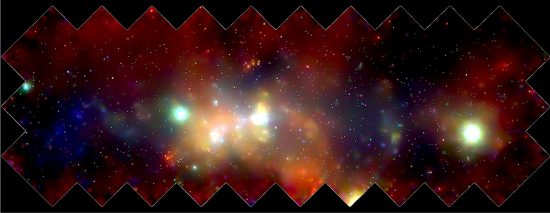
X-ray image looking toward the center of the Milky Way covering about 64 million cubic light-years. Credit: NASA/UMass/D.Wang et al. Click to enlarge.
Mar 7, 2018
The Solar System travels through space in an electromagnetic bubble.
“In order to understand the phenomena in a certain plasma region, it is necessary to map not only the magnetic but also the electric field and the electric currents. Space is filled with a network of currents which transfer energy and momentum over large or very large distances. The currents often pinch to filamentary or surface currents. The latter are likely to give space, as also interstellar and intergalactic space, a cellular structure.”
— Hannes Alfvén
Electric Sun theory states that the Sun is an anode in an interstellar electric circuit. The Sun’s negative pole is a cloud of ions called the heliosphere, billions of kilometers away. What plasma physicists refer to as “double layers” at the heliosphere’s edge isolate the Sun from the Interstellar Medium (ISM).
An electric discharge, called the solar wind, radiates from the Sun in all directions. It is transmitted to the edge of the Solar System at around 400 kilometers per second. Heat and so-called “light pressure” do nothing to explain the acceleration of charged particles as they pass by the planets on their way to the heliospheric cathode.
Charged particles in motion constitute an electric current that generates electromagnetic fields. The Voyager 1 team discovered electromagnetic fields holding the boundary of the heliosphere together in a sphere. The ISM must be electrically charged in order for that structure to exist. This observation confirms Electric Sun theory.
The now defunct Cassini mission to Saturn also contributed to understanding how the Sun interacts with its environment. Beginning in July 2004, Cassini plotted the position of energetic neutral atoms (ENA) near Saturn, along with their general disposition around the Solar System. The ENAs are created when protons, which are the main constituent of the solar wind, interact with the ISM’s electromagnetic field.
According to Edmond C. Roelof, and Stamatios Krimigis, former members of the Cassini mission team:
“Energetic neutral atom imaging has demonstrated its power to reveal the distribution of energetic ions…throughout vast structures in space….These images have revolutionized what we thought we knew for the past fifty years; the sun travels through the galaxy not like a comet but more like a big, round bubble. It’s amazing how a single new observation can change an entire concept that most scientists had taken as true for nearly fifty years.”
Previous computer models of the Solar System’s boundary region were written based on a presupposition; that the “collision” of the ISM with the solar wind as it “plows” its way through forms a “nose” and an elongated “tail”, similar to a boat wake. Electric Universe advocates predicted the opposite effect: charged particles and the ISM’s electromagnetic field produce a spherical shape.
As mentioned, the Sun’s electric field accelerates charged particles: the faster they accelerate, the stronger the field. As noted, however, the interplanetary electric field is extremely weak, but the solar wind acceleration over tens of millions of kilometers does confirm its electric field, enough to sustain a drift current across the Solar System. Within that spatial volume, the implied charge flow is sufficient to power an Electric Sun.
Stephen Smith












